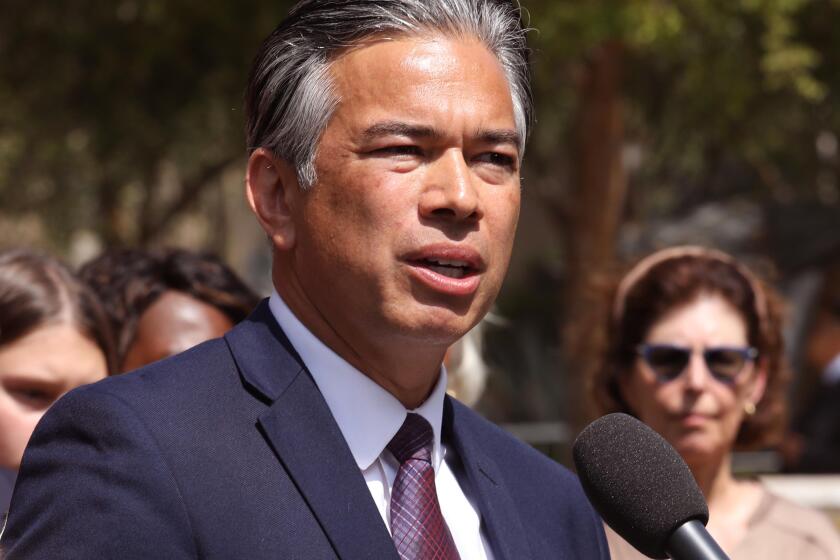CRISES SOUTH OF THE BORDER : Snipers Fire on Army Patrols in Separate Attacks in Chiapas : Mexico: One gunman is reportedly killed as incidents shatter military standoff. Action could foreshadow form of future guerrilla warfare.
- Share via
MEXICO CITY — Snipers have fired on army patrols in two incidents in Chiapas, shattering the tense military standoff in Mexico’s southernmost state and giving a glimpse of what a guerrilla war threatened by the Zapatista National Liberation Army would be like.
In a brief statement early Tuesday, Mexican Atty. Gen. Antonio Lozano confirmed that the army killed one assailant and captured three others in a gun battle after an attack Monday night in Ocosingo, a town that was a key rebel stronghold before President Ernesto Zedillo sent the army to retake all rebel-held territory nearly two weeks ago.
The other attack took place early Monday, the government said, in the pro-Zapatista town of Nuevo Momon. There a separate group of gunmen opened fire with high-powered rifles on patrolling soldiers. Nuevo Momon was the same town where suspected guerrillas ambushed and killed an army colonel and one of his men during the initial hours of Zedillo’s crackdown on the rebels.
Lozano said no soldiers were injured in this week’s attacks. His statement stopped short of calling the snipers Zapatistas, although it added that the army recovered a radio transmitter that is typical of rebel gear after the gunfight in Ocosingo.
This week’s sniper fire deepened fears that Chiapas may be on the brink of all-out guerrilla war.
It came as the Congress prepared to debate Zedillo’s draft of an amnesty law. That measure, the rebels have already said, would fail to meet their demands. But the president continued to vow that he will not withdraw the occupation force, which remains the major obstacle to new peace talks.
The latest Zapatista communique addressing Zedillo’s offer to reopen peace negotiations--an offer that was delivered Friday by members of a multi-party legislative commission that the president created to talk to the rebels in December--said the military has pushed the rebels so deep into the Lacandon rain forest that it is impossible to even meet to talk peace.
The communique said the Zapatistas are prepared to launch an all-out guerrilla war if the army continues to push the rebels “into a dead-end street.”
Meeting reporters after they returned to the nation’s capital, commission members stressed that they sympathized with the rebels’ position and were considering an offer to negotiate with them outside Mexico for the first time since the Zapatistas launched their uprising 14 months ago.
“The Zapatista army says that the physical conditions for dialogue do not exist, and certainly they are right,” said Rodolfo Elizondo, a congressman, commission spokesman and member of the opposition National Action Party, which supported Zedillo’s crackdown. “I believe any possibility can be made to fit, inside or outside the country.”
Ongoing efforts to work through the political impasse came as reports continued to mount from inside the jungle that thousands of villagers who fled the army advance Feb. 10 remain hungry and sick in makeshift refugee camps. Most told visiting reporters that they are too afraid to return to towns and villages where the military is digging in.
A doctor among one such group of about 800 indigenous Mexican peasants--mostly children--told a Reuters news agency reporter that most of the illnesses were from cramped living conditions and lack of food and water. He warned of a potential cholera outbreak.
A Times reporter who traveled to almost a dozen towns and villages controlled by the Zapatistas before the crackdown confirmed that most were virtual ghost towns; Red Cross and humanitarian workers have expressed concern about the vast number of refugees now without access to food and medical care.
Meantime, tension remained high in San Cristobal de las Casas, the second-largest city in Chiapas. In that city, pro-military demonstrators attacked the cathedral office of Roman Catholic Bishop Samuel Ruiz, a key mediator in the conflict, during a riot Sunday. Many protesters also called for the death of the controversial bishop, a strong advocate of equal rights for the state’s indigenous groups and poor.
Although most of Mexico’s conservative church has steered clear of the conflict, the Vatican’s semiofficial newspaper appeared to take a strong stand Tuesday. Reports from Vatican City stated that L’Osservatore Romano, in an article defending Ruiz, declared, “The landowners and economic powers of the region are trying with all their might to sabotage any dialogue and provoke an armed battle and the spilling of blood.”
More to Read
Sign up for Essential California
The most important California stories and recommendations in your inbox every morning.
You may occasionally receive promotional content from the Los Angeles Times.










